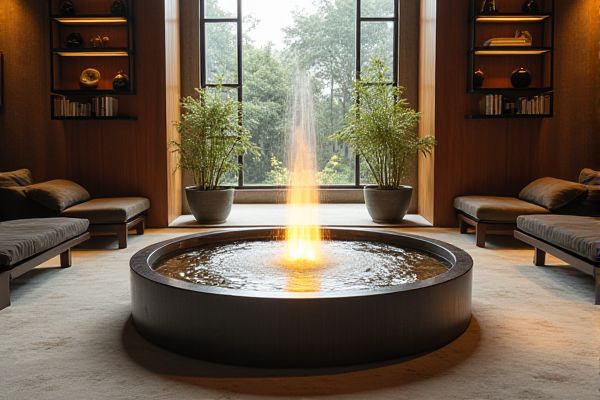
Kinetic sculptures captivate with their dynamic motion powered by wind, motors, or humans, offering an interactive artistic experience, whereas fountains blend visual beauty with the soothing sounds of flowing water to enhance outdoor spaces. Discover how these elements transform environments differently and which might best complement your space by reading the rest of the article.
Table of Comparison
| Feature | Kinetic Sculpture | Fountain |
|---|---|---|
| Definition | Artwork incorporating movement powered by wind, motors, or human interaction | Water installation that circulates or sprays water for decorative or functional purposes |
| Movement | Dynamic, mechanical or natural motion | Water flow and spray patterns |
| Main Elements | Metal, wood, motors, gears, wind vanes | Pumps, nozzles, basins, plumbing |
| Purpose | Artistic expression, interactive experience | Aesthetic appeal, cooling, ambient sound |
| Energy Source | Wind, electricity, manual power | Electric pumps |
| Location | Indoor and outdoor art spaces | Gardens, parks, plazas, indoor lobbies |
| Maintenance | Mechanical upkeep, lubrication, vandalism prevention | Water treatment, pump maintenance, cleaning |
| Interactivity | Often interactive or responsive to environment | Usually static, occasionally sensor-controlled |
Introduction to Kinetic Sculptures and Fountains
Kinetic sculptures involve moving parts powered by wind, motors, or human interaction, creating dynamic visual art that changes continuously. Fountains combine water flow and design to produce decorative displays often integrated with lighting and sound for enhanced sensory experience. Your choice between them depends on whether you prefer mechanical motion in solid materials or fluid movement and tactile water effects.
Historical Origins and Evolution
Kinetic sculptures originated in the early 20th century, evolving from the Futurist movement's emphasis on motion and later influenced by artists like Alexander Calder, who pioneered mobiles that blend art with engineering principles. Fountains, with origins tracing back to ancient civilizations such as Mesopotamia and Rome, have historically served both practical water distribution and decorative purposes, evolving through Renaissance and Baroque periods into elaborate displays integrating hydraulic innovation. Your appreciation of these forms deepens by understanding how kinetic sculptures reflect modern artistic exploration of movement, while fountains embody centuries of technological and aesthetic development.
Key Design Principles
Kinetic sculptures emphasize dynamic movement through mechanical or natural forces, incorporating principles of balance, motion, and interaction to create engaging, ever-changing forms. Fountains focus on water flow patterns and hydraulic engineering, prioritizing fluid dynamics, water pressure, and aesthetic integration with surrounding architecture or landscape. Both designs harness physical forces, but kinetic sculptures prioritize mechanical motion while fountains specialize in the controlled movement of water for visual and sensory impact.
Artistic Functions and Purposes
Kinetic sculptures emphasize movement and interactive engagement, transforming static art into dynamic experiences that captivate viewers through mechanical or natural motion. Fountains primarily serve as aesthetic and sensory elements in public spaces, combining water flow and sound to create calming and visually stimulating environments. Both forms enhance spatial design by integrating art with environmental elements, but kinetic sculptures prioritize motion-driven expression while fountains highlight fluidity and auditory ambiance.
Materials and Construction Techniques
Kinetic sculptures commonly utilize lightweight materials such as aluminum, stainless steel, and acrylic to facilitate movement, paired with precision bearings and motors for dynamic motion. Fountains employ durable, water-resistant materials like stone, concrete, bronze, and waterproof sealants to withstand constant moisture and ensure structural integrity. Construction of kinetic sculptures integrates mechanical engineering for balance and fluidity, while fountain construction focuses on hydraulic systems and water circulation to create visually appealing water displays.
Movement in Art: Motion vs. Water Flow
Kinetic sculptures harness mechanical or natural forces to create dynamic movement, engaging viewers through shifting forms and changing perspectives. Fountains utilize the continuous flow of water to produce fluid motion, often emphasizing rhythm and tranquility in outdoor or indoor spaces. Your appreciation of movement in art deepens by comparing the tactile, oscillating energy of kinetic sculptures with the soothing, rhythmic patterns of water in fountains.
Interaction with Environment
Kinetic sculptures harness wind, sunlight, or human touch to create dynamic movements that respond to environmental stimuli, offering a constantly evolving visual experience. Fountains interact primarily through water flow and sound, utilizing gravity and water pressure to produce fluid motion and cooling effects within outdoor spaces. Both forms enhance their surroundings by engaging sensory elements, but kinetic sculptures emphasize movement variability, while fountains focus on water's soothing presence and rhythm.
Sensory Experiences: Visual, Auditory, and Tactile
Kinetic sculptures engage your senses through dynamic visual movement and subtle auditory sounds created by shifting parts, offering a tactile experience as you observe the evolving forms. Fountains deliver a continuous auditory backdrop with flowing water, combined with visually mesmerizing water patterns and the refreshing tactile sensation of mist or droplets. Both art forms create immersive sensory environments, but kinetic sculptures emphasize mechanical motion, while fountains highlight natural water dynamics.
Maintenance and Sustainability
Kinetic sculptures typically require regular maintenance to ensure moving parts remain functional and durable, often involving lubrication and mechanical inspections. Fountains demand continuous water treatment and pumping system upkeep to prevent algae growth and water evaporation, impacting both water usage and energy consumption. Your choice should consider the long-term sustainability of materials and the environmental impact of operational needs.
Cultural Impact and Modern Trends
Kinetic sculptures and fountains both serve as dynamic public art forms, but kinetic sculptures emphasize movement powered by mechanical or natural forces, creating interactive experiences that challenge traditional static displays. Fountains often symbolize life and purity across cultures, integrating water's sensory appeal with artistic design to enhance urban landscapes and communal spaces. Modern trends in kinetic sculptures include the integration of technology like solar power and programmable motion, while fountains increasingly incorporate LED lighting and sustainable water recycling systems, reflecting evolving environmental and aesthetic values.
 homyna.com
homyna.com